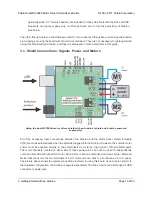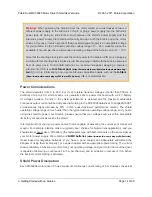
Warning:
When powering the Arduino from the motor shield, you must
never
connect a
different power supply to the Arduino’s VIN pin or plug a power supply into the Arduino’s
power jack, as doing so will create a short between the shield’s power supply and the
Arduino’s power supply that could permanently damage both the Arduino and the motor
shield. In this case, it is also important that your shield power supply is an acceptable voltage
for your Arduino, so the full shield operating voltage range of 5 – 28 V probably will not be
available. For example, the recommended operating voltage of the Arduino Uno is 7 – 12 V.
Note that the shorting block just routes the motor power to the Arduino VIN pin, so plugging
in USB with this shorting block in place is just like plugging in USB with the Arduino powered
from its power jack. On standard Arduinos we recommend against plugging a powered
Arduino into USB (see
this forum post
[https://forum.pololu.com/t/pololu-arduino-hardware-bug/
2461/7]
for more information), but on some Arduino-compatible boards such as the
A-Stars
[https://www.pololu.com/category/165/a-star-32u4-prime]
, this is completely safe.
Power Considerations
The shield operates from 5 to 28 V, but it can tolerate transient voltages (shorter than 500 ms in
duration) of up to 40 V, which means it is generally safe to power this board with a 24 V battery.
At voltages between 5 and 8 V, the shield performance is derated, and the maximum achievable
continuous output current will be decreased (according to the MC33926 datasheet, H-bridge MOSFET
on-resistances might increase by 50% in this “quasi-functional” performance region). The shield
operating voltage range is much wider than the typical Arduino operating voltage range, so if you are
using the shield to power your Arduino, please ensure that your voltage source is within acceptable
limits for your Arduino as well as the shield.
It is important that you use a power source that is capable of delivering the current your motors will
require. For example, alkaline cells are typically poor choices for high-current applications, and you
should almost never use a 9V battery (the rectangular type with both terminals on the same side) as
your motor power supply. We recommend
NiMH batteries
[https://www.pololu.com/category/54/batteries]
,
lithium-based rechargeable batteries (if you have a good charger and adequately understand the
dangers of using them improperly), or a power adapter with an appropriate power rating. The current
draw is ultimately a function of your motors, your operating voltage, and your motor load, but the driver
is capable of delivering a continuous 6 A (3 A per channel), and it can deliver in excess of 10 A before
the internal current limiting is activated.
Shield Power Dissipation
Each MC33926 motor driver IC has a maximum continuous current rating of 5 A. However, the actual
Pololu Dual MC33926 Motor Driver Shield User’s Guide
© 2001–2017 Pololu Corporation
3. Getting Started with an Arduino
Page 14 of 30















































